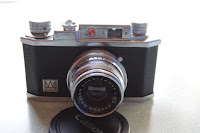 |
| Meisupii J |
This is a small, cheap Japanese camera dating from 1951. The camera is 104 x 70 x 59 mm and weighs 190g - this is quite light and is due to the aluminium alloy construction. The only part that is not aluminium is the shutter which is brass. The basic physical design is the one common to many cameras of the period and is loosely (very loosely) based on the Leica, the sine qua non of camera design of the time. The following three photographs show the general similarity in outline and layout.
| Leica IIIf (c) Rei Shinozuka |
 |
| Halina 35X |
 |
| Meisupii J |
This even extends to a small splash of red, in this case the letter 'J', in remembrance of the Leica's red dot.
The Meisupii J has a number of knurled knobs and rings giving the impression that things can be adjusted. of then two knobs on the top plate, only one turns - the film advance. The two knurled knobs on the base plate do not turn and the two knurled rings on the lens/shutter housing also do not turn.
There are adjustments, however. There are two shutter speeds - I and B. I is Instantaneous and B is Bulb. Instantaneous is around 1/50 seconds and B, as usual, leaves the shutter open while the release is depressed. The release button almost gives the impression that it is threaded for a cable release but it is not.
Also adjustable is the aperture with two f-stops - f8 and f11. These are Waterhouse stops - holes in a moveable metal plate - rather than an iris diaphragm. These holes have clearly been punched rather than drilled as the f8 stop is not quite circular.
The lens is a meniscus lens as far as I can see and does not appear to be coated. The lens fascia is inscribed 'Meisupii 35' which suggests a 35mm lens which is slightly wide angled for 35mm film.
This camera takes Bolta film which is unperforated 35mm film wound onto a spool with backing paper like 120 film. This was introduced in Germany in 1936 at as time when 35mm film was becoming popular but was not yet readily available in pre-filled cassettes. Bolta format film was introduced into Japan in the late 1930s as Boltax film and was used until the late 1950s.
As with 120 film, the frame positions are indicated on the backing paper with numbers viewed through a window on the camera back. Strangely, this window is coloured green rather than the usual red although with the introduction of panchromatic film (which was the usual film by 1951) the colour of the window is immaterial.

No comments:
Post a Comment